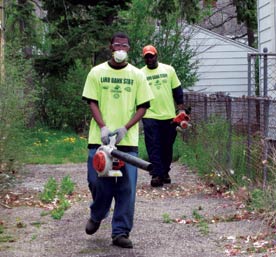Housing counselors and advocates have been insisting for years that principal reduction is the only way to sustainable loan modifications and neighborhood stabilization—and that it is better for investors too. Their points have largely fallen on deaf ears. So when Ocwen Financial, a leading, and fast-growing, servicer of subprime loans introduced an ambitious principal reduction program last year, we took notice.
Shelterforce: Please tell me a little bit about yourself and your experience at Ocwen.
Ron Faris: [Before Ocwen] I worked for about five years at a Wall Street company that’s no longer around, Kidder Peabody, and was owned by GE at the time. That’s where I got my introduction to the mortgage business. I joined Ocwen in 1991, and my first role was as the controller for a mortgage insurance company that Ocwen owned at the time.
What a mortgage insurance company does is, obviously, writing policies to insure losses. If a loan does go into default, the first loss is going to go to the insurer. So the insurer has a vested interest in making sure there are quality workout solutions to minimize losses.
When I joined in ’91, Ocwen basically had two businesses. We had the mortgage insurance company, which had stopped writing new policies but was still receiving premium income from existing policies and managing its claims process, and took an active role in managing and working with servicers to more effectively deal with delinquencies.
The other piece of our business was a bank the form of a Thrift, and that Thrift got involved with buying subperforming and nonperforming mortgage loans from the RTC, which again was all about how do you more effectively find workout solutions for borrowers and minimize the loss on your investment. So back then the losses were ours, whether it was on the insurance company side or on the assets that we owned in the Thrift.
We learned pretty quickly that we lost a lot more money if we ended up going all the way through to foreclosure than we did if we were able to find a way to keep the homeowner in the home and get them paying again. And that really became the basis for how we approached loss mitigation.
Our business progressed to where we were a pretty large buyer of nonperforming mortgage loans from the RTC and then from banks and others. But as we got towards 1996, 1997, 1998, the company actually went from a private company to a public company, and — although it pales in comparison to today — there was also in ’98, ’99 a credit crisis that caused some problems for smaller, mid-sized finance companies. We weathered that storm quite well, but a lot of others didn’t. [But we] changed our business model and decided we would no longer buy assets for our own account, but we would instead just service assets for other parties who either wanted to invest in loans or already had an investment and needed help with their delinquent loans.
We had a very robust platform that we were under-utilizing, and also we found that the banks, and especially the larger banks, had a much lower cost of capital and could buy assets and finance them cheaper. So we said, “Well, we’ll never beat them on the capital side, but we can probably always beat them on the servicing and special servicing side, so why don’t we just go out to them and say, ‘Look, you’re good at raising low-cost capital and we’re good at servicing loans and minimizing losses. Why don’t we combine forces?’”
Now, as it turned out, probably the place — at least in the early to mid 2000s — where that model seemed to fit best was actually as a result of the boom in the subprime market. As the amount of subprime loans increased, and as Wall Street in particular got more involved with it, there was a much larger demand for servicers who could handle pools of loans that had a lot of delinquencies in them, and so that became a prime focus of ours throughout most of the 2000s.
You must have seen the future clearly by 2004.
Ron Faris: Well, I should really compliment people like Mark Seifert of ESOP and others in the consumer advocacy world, who saw it long before industry saw it. I can remember sitting down with various advocacy groups and them talking about the struggles families were having and how the subprime market was a big part of the problem and, in their view, not a sustainable model.
I remember — I think it actually was in Cleveland, ESOP taking me around and showing me — walking down a street and saying, well, here’s a house on one side that’s really well kept, really nice. Here’s a house on the other side that actually at one time Ocwen foreclosed on. They sold the real estate to an investor who got a subprime loan from Ameriquest and within nine months went delinquent again, and the home was back sitting on the street in foreclosure in relative disrepair. It was very clear, when you saw it firsthand, how that was affecting not just that one isolated house but the houses all around it. So I think I got a lot of my education in what was to come from some of the advocacy groups who were showing me what was really happening in the neighborhood.
For us, though … we were not an originator. We were not an investor in the loan. So there wasn’t a lot that we had to change besides just making sure that we were prepared for the increase in delinquencies that had started and was likely to continue.
By no means is it a good thing what’s happened. But for Ocwen, our business model was actually more prepared for where the world has gone than I’d say most other servicers, which obviously on the larger scale is unfortunate, but it did require greater demand for our services.
Now, there was a short period where demand dried up because there was no longer a subprime business, so there was no new business coming in. But you’ve seen over the last few years, players looking to exit that legacy business and we now have the opportunity to consolidate what’s left and grow the number of accounts that we’re managing.
You just purchased the servicing rights to a number loans, such as the Litton portfolio from Goldman Sachs and part of the Chase portfolio.
Ron Faris: Right, as well as the entire HomEq portfolio and servicing platform that was owned by Barclays. We purchased that in 2010. And we recently announced our purchase of Saxon Mortgage from Morgan Stanley, which we anticipate closing in this quarter. These deals are available mostly because those companies — Barclays, Goldman Sachs, Morgan Stanley — are looking to exit the mortgage servicing business altogether. In the case of Chase, I think they determined that there may be certain portions of their portfolio that either were not core and were more suitable for somebody set up like we are.
You said that you figured out early on that you lost a lot more money going to foreclosure than doing a good workout. No doubt you’ve heard from Mark and other advocates how hard it’s been to convince banks and servicers that that’s the case. How do you account for the resistance in the rest of the mortgage industry?
Ron Faris: I think it was largely because a lot of the mortgage industry was focused on the origination side of the business, was not out there seeing what was really going on in neighborhoods.
But being a subprime servicer, we serviced loans that were originated by New Century, by Ameriquest, by Option One, by Accredited, all of the originators out there. Even though some of them had their own servicing operation, we ended up with loans from all of them because they sold to Wall Street and Wall Street would hire us to do the servicing. So we had a good cross-section of what was going on throughout the industry.
And again, I don’t want to overstate that I — or anyone at Ocwen — was fully able to predict what was happening out there. The difference for us was we didn’t own any of the risk and our job was to service the loans. If they went delinquent, then that’s when we were at our best in working with customers. We just kept doing what we were doing. We were just doing more and more of it.
In 2008 you got significant pushback from the bond holders for your aggressive modifications, with principal reductions, of loans in their securities. How was that resolved?
Ron Faris: Yes. Towards the end of 2007 in particular was when there was a big shift, at least on our thinking. Although we always found that it was best to keep borrowers in their home, up until 2007, you could generally keep somebody in their home if they had a temporary disruption in their ability to pay. You could usually spread that delinquency that occurred during the disruption out, sometimes over maybe three years, if need be, and allow them to catch up gradually.
But you never really had to truly modify the terms of the loan. What we think of today as a loan modification was very rarely used up until 2007, and partly it was because people had jobs, property values were going up. Until that point in time, if somebody lost their job for three months or they had a medical issue, they would get behind, but you could start working with them, and as long as you were flexible, you could get them back paying.
But by mid-2007 to late-2007, it became clear to us that the strategy that had worked for a long time no longer worked, that borrowers’ property values were not going up. In fact, they were going down. There was no chance for them to ever refi. Their incomes were not only not going up, in many cases they were starting to go down, maybe they were losing overtime, bonuses weren’t there, or if they were self-employed, instead of working 50 hours a week they could only work 35 hours a week.
So we started to realize that strategy would no longer work. We’re not seeing people with temporary problems. We’re seeing them with what appear to be long-term problems. It was just simply they could no longer make their mortgage payments.
That was when we realized that loan modification was really the only solution. And with property values starting to go down, we realized, even in 2007, 2008, that many of these homeowners were underwater. We looked at it and said “When we do the net present value calculation to determine what you are going to get if you do a modification versus what you are going to get if you foreclose, well, you weren’t going to get any of the amount that they were underwater if you foreclosed anyway.”
So actually, a principal reduction loan modification looked at the time like it would be the best solution for the homeowner and really shouldn’t be any worse off for the investor. The problem was that not all investors were created equal. Certain investors were going to take that write-down as an immediate loss as opposed to being able to defer it over some longer period of time.
There was also a little bit of the moral hazard question. The borrowers signed a note. Why is it fair that they’re getting some of the money that was lent to them forgiven? We said it’s all about minimizing your loss, and the best way to do that is get them paying, and get them paying as much as they can over a long period of time. It’s just not realistic to think that they’re going to pay over a long period of time if they’re underwater.
But we were the lone wolf out there. Nobody else in the industry, that I am aware of, was doing any meaningful amounts of principal reduction. And unfortunately, we buckled to the pressure and, for a time, we definitely scaled it back almost to the point of suspending it and moved more to the traditional modification, which just lowered interest rates, extended amortization period, those kind of things.
What brought you back to doing principal reductions?
Ron Faris: We eventually came back to greater use of principal reduction as the underwater mortgage problem got worse. Next to unemployment, negative equity is the largest driver of delinquencies. Our data shows that a borrower with negative equity is two to three times more likely to default than one with even some small portion of positive equity.
It seems that every pooling and servicing agreement is written differently. Does the PSA contractually limit your ability to reduce principal?
Ron Faris: No. In the private-label security world, trust me, I heard a lot of those same stories very early on. And yet, when we actually read our documents, we found less than 10 percent, closer to only about 5 percent of the time, was there any true restriction on how you could work out a loan. Except for that small percentage, our PSAs are silent about modifications. But every PSA has one thing in common: they dictate that the servicer must service loans, and resolve delinquencies, in the best interest of the investor, ie, the loan owner. So where our net present value analysis shows that a principal reduction modification that is sustainable by the homeowner will likely return more cash flow to the investor than a foreclosure, we are not only legally permitted to do that type of mod, we are arguably required to do it.
As long as you were working out a loan with the intent of maximizing the value for the trust or the investor, there was nothing specific that said you couldn’t lower an interest rate or you couldn’t extend the amortization period, or you couldn’t do a principal reduction. Even though people said over and over that that’s why they couldn’t do anything, it really did not exist in the vast majority of the documents.
Investors still, I think from time to time, question whether modifications are what should be done to maximize their investment. But as far as explicit contractual restrictions, they generally were found not to exist.
Now, the GSE world is different in that Fannie and Freddie and FHA set policy on how their loans are going to be dealt with, and you have to go to them for approval for every single workout that you do. And if they’re not doing principal reductions, they’re not doing principal reduction. There’s no way around it.
We were able to prove through our modeling and everything that [principal reduction is] a win for the investor in the loan. And oh, by the way, it’s a win for Ocwen too because, as a servicer, if we foreclose, we lose that asset, and we lose any ability to earn anything off of it. Whereas, if we are able to keep the homeowner in the home paying on that existing loan, then we continue to make a servicing fee for hopefully many years to come.
I can see why everyone from George Goehl to John Taylor have good things to say about Ocwen. What kind of relationships do you have with the counseling agencies?
Ron Faris: It depends on the type of agency. Some of them are more central, like National Council of La Raza, or at the time, when you said George, you’re talking about NPA?
Yes.
Ron Faris: Yes, although they’ve kind of changed their focus a little bit more recently. But when we first met them, they were one of the first groups we worked with. They were an umbrella for a number of groups that were in Iowa and Cleveland and Chicago and Pittsburgh and other places. We would work with their affiliated groups to train them on what we do and we got better educated to what they did. We then showed them: here’s the information that we need and here’s who you go to if you have a customer who’s an Ocwen borrower. We set all that up so that it would be streamlined, and then we took the extra step and said, “What we want to do is tell you who our delinquent accounts are in your location, and we want you to help us track them down and work with them, and get them through the process so that we can help them.”
And we would provide some financial support to each of the individual offices, or at the [national] level and then they would disburse the money out to partly help fund their activities. I think we were one of the first ones to actually do what has evolved to what we’ll call “pay for success,” meaning for every homeowner that you work with who’s an Ocwen homeowner, we’ll pay you something on a per-homeowner basis. It allows us to know that we’re spending the dollars with the groups that are helping the most people, and it also provides them the knowledge that, if they have people who they need to help, if they’re an Ocwen customer, that they know they’re going to get maybe modest but some funding to help them continue their own activities.
And ESOP is always one of the best examples of where they just did a fantastic job of helping high volume of people. The dollars went to the groups that were helping the most people.
You made some suggestions about HAMP, and one of them was to either have a flexible front-end debt-to-income ratio (DTI) to qualify for assistance, or at least bring it down from 31 percent to 28. Do you do that?
Ron Faris: Yes. We have always been a big supporter of HAMP, but we recommended various improvements, including more flexibility on the DTI. Look, if two people have an $80,000 income, but one person is single, the other person has three kids, a dog, and who knows what else, the single person in theory has more of it available to put towards housing, than the person with three kids and the dog. Right? There are all kinds of reasons why 31 percent isn’t the perfect solution.
But again, I don’t think HAMP is a bad program. I actually think it’s brought a lot of really great benefits.
You testified that it was a “well-designed response to the mortgage crisis.”
Ron Faris: Yes, and it is, for all its criticism, I actually think that the industry and homeowners are much better off because of HAMP simply because it provided some standardization and clarity on what things made sense. And you could take those same principles and go beyond those if you wanted to, which we have.
When we’re evaluating somebody for HAMP, we will look at their circumstances beyond just their gross income. And for some people, a 25 DTI might be the right number. For others, we might actually think that 34 is okay. Now, if they qualify for HAMP, HAMP requires that we go down to 31, so we will go to 31, even if we think they could afford a little more, because that’s the program. But if we think they can only afford 25, then we’ll put them at 25. The benefits of HAMP that go to the investor and all that only accrue [for bringing a borrower] down to 31, but there’s nothing prohibiting a servicer from going below that. And we do do that.
Besides the flexible DTI, are there any other ways that HAMP can be improved?
Ron Faris: I advocated that they make principal reductions more of a requirement or priority. At the time it was an option, and to the extent anybody even did use the option, they generally were using the principal forbearance option. Which to be honest, Ocwen was using also because that was the guideline that everybody was using.
But I advocated for [principal reduction] because I thought, for borrowers who are underwater, over the long-term these are not going to be sustainable. And the program did move much more in that direction. I don’t know that everybody’s taken full use of that, but I think that was a very positive thing.
For a government program, there has to be a cutoff somewhere. One of the frustrations we find with HAMP is that we’ll get a borrower with a DTI of 30, but they still can’t afford their payments and they can’t be helped under HAMP. The reason I’m not too critical of that with HAMP is that there’s nothing stopping me from doing a non-HAMP modification for that person. I may not get the HAMP benefits and the investor may not get them. But there are plenty of people who have a DTI even below 31 that are still struggling and need help and need a modification, and we give those all the time. We just do it outside of HAMP because they don’t qualify for HAMP based on that criteria.
How did you develop the shared appreciation modification program and how does it work?
Ron Faris: Well, as we talked about before, to adequately deal with the underwater mortgage problem – which according to published statistics affects about 11 million families in the U.S.—we realize that you’ve got to include principal reduction for long-term sustainability. We also needed to address the issue of investors not always being happy that principal’s being forgiven.
In the SAM program, we incentivize the borrower to continue to make their payments by saying, “Look, you only get this principal reduction on a permanent basis if you continue to make your payments. And you will get a third of the reduction in each of the first three years if you continue to make your payments.” Investors were much more willing to accept something like that for two reasons. One, they felt that it was motivation for the borrower. And they realized that, if a borrower defaulted early on, that they weren’t giving up as much principal.
And then the last piece was to add in, “Oh, and by the way, if the property value goes back up, we’ll let the investor share that upside. Not all of it, but some of it.” And the investors really liked that. [See Uncle Sam Outdone by Ocwen’s SAM, SF #167.]
And so when you had both advocacy people, who really were speaking for the consumer, and the investors saying, “OK, well, this sounds good, it doesn’t sound like anything we would object to,” it really became our preferred way to do a modification.
We of course wanted to make sure that this type of modification program was compliant with various state laws and regulations. We designed it, for example, to make sure any shared appreciation piece would be compliant with state usury laws. We also spent a lot of time researching things like disclosures to be included in the mod documents. In some states the regulators have said, “Look, we have no objection to it, and we actually like it, but we would first need to have a specific regulation in place covering this type of program, so let us try to work to get that done.” We’ve been able to roll it out in 34 or 35 states, maybe even a few more now, and we are working with regulators in the other states to obtain their blessing.
Is this going to be the way you do principal reductions from now on?
Ron Faris: Yes. It really is only not done that way if it’s in a state where we don’t feel we have explicit authority to do it. Or if we’ve already done one. You get one shot at a principal-type reduction and a shared appreciation, and if you, unfortunately, can’t make it there, doesn’t mean that we won’t still work with you, but you’re probably not going to get another one of those.
What happens when the modification doesn’t work? Do you have a set of next steps, Plan B, Plan C?
Ron Faris: Well, in most cases, Plan B is figure out, well, has something changed? I mean, really, why didn’t this work the first time? Did we not underwrite it correctly? Did the borrower’s circumstances change? Or did the borrower just sort of not live up to obligations that they probably could live up to if it was a priority?
And if their circumstance change, or if in fact we determine, when we underwrote it, maybe we didn’t take into account certain things that we should have, then we have no problem looking at a second modification. Now, if it’s a case where they’re just not acting responsibly, well then that’s a different story. Those people either are going to have to step up and try to reinstate, or they may ultimately be the one that loses their home.
Right. So for the ones who do want to act responsibly but, because of illness or loss of employment they’re just not going to be able to do a mortgage, you can’t bring it down low enough or there’s no income, what then?
Ron Faris: Yes, those are really the hard ones. If somebody doesn’t have any income, or they have very little income, you need to find some other alternative, and that alternative is not going to be homeownership or ongoing homeownership.
Do you encourage or try to do a short sale or deed in lieu before going all the way through foreclosure?
Ron Faris: Yes. In fact, we’re trying to roll out a program starting next year that we call our Homeowners One program, where if somebody really can’t make the payments, that we have a little more of a structured response. So we can say, “Look, we want you to help us get you a short sale. We want to work with you. We want you to know you’re going to be able to stay until at least this date. And we’ll, in fact, give you some relocation funds.”
My problem with the general short sales that are out there is I’m not really sure they’re all in the best interest of the individual. The real estate agents sometimes are just trying to get a commission and trying to tell the people, “Well, look, let’s sell your house, and we’ll do a short sale, and you’ll be better off.” I’m not always sure they’re better off. If they didn’t get any money to help them relocate or if they could have maybe stayed a little bit longer and saved a little bit of money so they’re better able to move, that might have been better than a quick-and-dirty short sale where they get nothing out of it.
So we’re trying to be responsible on the short sale side as well, and trying to go to the next level where it’s a much more, I’ll call it, borrower-friendly program than maybe the industry is using today.
Thank you.






Comments